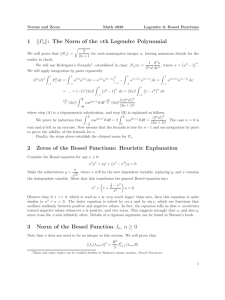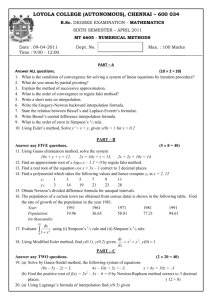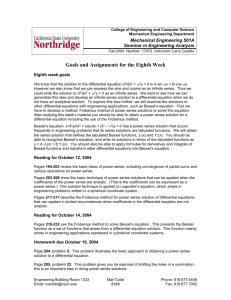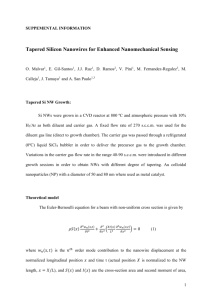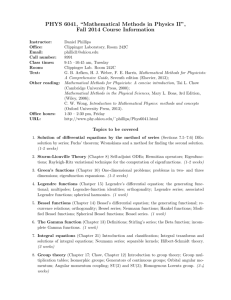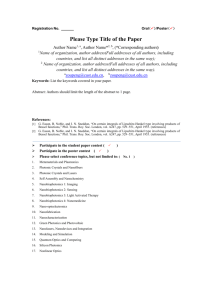Notes on Special Functions Introduction Francis J. Narcowich Department of Mathematics
advertisement
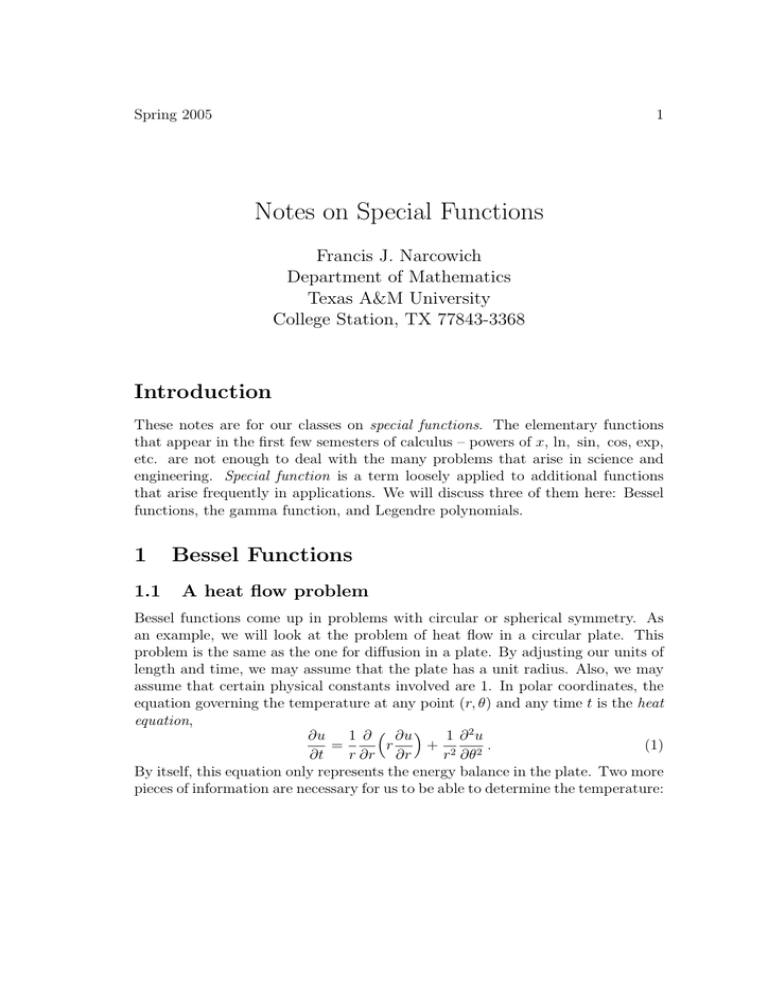
Spring 2005
1
Notes on Special Functions
Francis J. Narcowich
Department of Mathematics
Texas A&M University
College Station, TX 77843-3368
Introduction
These notes are for our classes on special functions. The elementary functions
that appear in the first few semesters of calculus – powers of x, ln, sin, cos, exp,
etc. are not enough to deal with the many problems that arise in science and
engineering. Special function is a term loosely applied to additional functions
that arise frequently in applications. We will discuss three of them here: Bessel
functions, the gamma function, and Legendre polynomials.
1
1.1
Bessel Functions
A heat flow problem
Bessel functions come up in problems with circular or spherical symmetry. As
an example, we will look at the problem of heat flow in a circular plate. This
problem is the same as the one for diffusion in a plate. By adjusting our units of
length and time, we may assume that the plate has a unit radius. Also, we may
assume that certain physical constants involved are 1. In polar coordinates, the
equation governing the temperature at any point (r, θ) and any time t is the heat
equation,
∂u
1 ∂ ³ ∂u ´ 1 ∂ 2 u
=
(1)
r
+ 2 2.
∂t
r ∂r ∂r
r ∂θ
By itself, this equation only represents the energy balance in the plate. Two more
pieces of information are necessary for us to be able to determine the temperature:
the initial temperature, u(0, r, θ) = f (r, θ), and the temperature at the boundary,
u(t, 1, θ), which we will assume to be 0. These are called the initial conditions
and boundary conditions, respectively.
Solving these equations is done via a technique called separation of variables.
In this technique, we simply ignore the initial conditions and work only with the
heat equation and the boundary condition u(t, 1, θ) = 0. We will not go through
the whole procedure here. Instead, we will step in at the point where Bessel
functions come into play. The idea is to look for a solution u to (1) that satisfies
the boundary condition u(t, 1, θ) = 0 and that has the form
½
cos(nθ)
−λt
u(t, r, θ) = e R(r)
,
sin(nθ)
where n is an integer and is given. The constant λ > 0 and the function R(r)
are unknown. A solution having this form satisfies the boundary condition if and
only if R(1) = 0. If we substitute u into (1), then, with a little calculus and some
algebra, we find that R satisfies the ordinary differential equation,
d2 R
dR
+r
+ (λr2 − n2 )R = 0 .
(2)
2
dr
dr
√
Finally, we make a change of variables x = λ r and y(x) = R(r). By the chain
dy
d2 y
1 d2 R
rule, we get dx
= √1λ dR
and dx
2 = λ dr 2 . Using these in the previous equation,
dr
we get this,
2
√ dy
2 d y
λ r}
λr
+ (|{z}
λr2 −n2 )y = 0 ,
+
|{z} dx2 | {z
dx
2
2
r2
x
x
x
from which it follows that
dy
d2 y
+ x + (x2 − n2 )y = 0.
2
dx
dx
This is Bessel’s equation and its solutions are Bessel functions.
x2
1.2
(3)
Bessel’s equation and the method of Frobenius
We are going to solve Bessel’s equation (3) using a power series method developed
in the nineteenth century by the German mathematician Ferdinand Frobenius.
The usual power series method won’t work because Bessel’s equation has a singularity at x = 0. Instead, we will assume that there is a solution of the form
∞
X
y(x) =
ak xβ+k , a0 6= 0,
(4)
k=0
2
where β can be fractional and doesn’t have to be a non-negative integer; β is
sometimes called an index.
We are going to substitute y(x) into (3). Before we do that, we will put (3)
into a form that’s easier to use:
d ³ dy ´
x
x
+ (x2 − n2 )y = 0
(5)
dx dx
We need to calculate three series. The first is just this:
∞
X
d ³ dy ´
d ³ d β+k ´
x
x
=
x x
ak x
dx dx
dx dx
k=0
=
∞
X
(β + k)2 ak xβ+k
k=0
2
= β a0 xβ + (β + 1)2 a1 xβ+1 + · · · + (β + k)2 ak xβ+k + · · · .
The second series is this one:
−n2 y = −n2 a0 xβ − n2 a1 xβ+1 − n2 a2 xβ+2 − · · · − n2 ak xβ+k − · · · .
The final series is:
x2 y = a0 xβ+2 + a1 xβ+3 + · · · + ak−2 xβ+k + · · · .
From (5), the sum of the three series is identically 0. Thus, we have that
(β 2 − n2 )a0 xβ + ((β + 1)2 − n2 )a1 xβ+1 + {((β + 2)2 − n2 )a2 + a0 }xβ+2 +
···
+ {((β + k)2 − n2 )ak + ak−2 }xβ+k + · · · ≡ 0 .
As is the case for ordinary power series, the only way the series above can vanish
identically is for the coefficient of each power to be 0. This implies that the
following equations hold:
(β 2 − n2 )a0 = 0 (Indicial equation)
((β + 1)2 − n2 )a1 = 0
((β + k)2 − n2 )ak + ak−2 = 0, k ≥ 2 (Recursion relation).
(6)
(7)
(8)
The indicial equation (6) gives us that β 2 = n2 , since we assumed that a0 6= 0
at the start. Consequently, β = ±n. We will take β = n ≥ 0 for now. Later
3
on, we will explain what happens if we take β = −n. Also, it is not necessary to
assume that n is an integer.
The next equation in our list is (7). With n ≥ 0, the factor (β + 1)2 − n2 =
(n + 1)2 − n2 > 0, so we may divide by it to get a1 = 0.
The last equation (8) is the recursion relation. The coefficient of ak is positive,
and so we can divide by it to put (8) in the form
ak−2
(n + k)2 − n2
ak−2
= −
.
k(k + 2n)
ak = −
(9)
a1
= 0. A similar calculation
If we put k = 3 in (9), then we get a3 = − 3(2n+3)
shows that a5 = 0, a7 = 0, and that in general aodd k = 0. To take care of the
even k, replace k by 2k in (9) and simplify to get
a2k = −
a2k−2
2
2 k(k +
n)
(10)
At this point, we iterate (10).
a0
· 1 · (n + 1)
a2
(−1)2 a0
= − 2
= 2+2
2 · 2 · (n + 2)
2
· 1 · 2 · (n + 1)(n + 2)
(−1)3 a0
a4
= 2·3
= − 2
2 · 3 · (n + 3)
2 3!(n + 1)(n + 2)(n + 3)
..
.
a2k−2
(−1)k a0
= − 2
= 2k
2 · k · (n + k)
2 k!(n + 1) · · · (n + k)
a2 = −
a4
a6
a2k
22
We now can write down the series for y(x), which is
n
y(x) = a0 x +
∞
X
k=1
(−1)k a0 x2k+n
22k k!(n + 1) · · · (n + k)
(11)
We point out that this series is actually a valid solution to Bessel’s equation
for any value of n, except for negative integers. The Bessel functions we will
define below are simply ones with a particular choice of the constant a0 . When
4
n = 0, 1, 2, . . ., the constant a0 is chosen to be a0 = 1/(2n n!). Using this and
again doing a little algebra, we can put y in the form
∞
X
(−1)k ³ x ´2k+n
Jn (x) :=
(12)
k!(n
+
k)!
2
k=0
The function Jn (x) is called the order n Bessel function of the first kind. Of
course, it solves (3). For non-integer n, a similar expression holds, except that
(n + k)! gets replaced by a gamma function, Γ(n + k + 1),
∞
³ x ´2k+n
X
(−1)k
Jn (x) :=
(13)
k!Γ(n + k + 1) 2
k=0
We will discuss the gamma function later. For now, we note that if m ≥ 0 is an
integer, then Γ(m + 1) = m! .
1.3
Orthogonal series of Bessel Functions
Recall that in discussing the heat flow problem in section 1.1, we arrived at an
eigenvalue problem in which we needed to find a function R(r) that satisfies (2),
the condition R(1) = 0, and is continuous at r = 0. We then reduced
that
√
problem to solving Bessel’s equation (3), with y(x) = R(r) and x = λ r. Now,
what we have seen is that y = Jn (x), which is defined by the series in (12),
n
solves (3). Also, for any integer n ≥ 0, the solution behaves
√ like x near x = 0,
so it is continuous there. We thus have that R(r) = Jn ( λ r) satisfies two of
three
√ conditions on R.
√ The last one is that R(1) = 0, and it will be satisfied if
Jn ( λ) = 0 – i.e., if λ > 0 is a positive zero of Jn . (For all n > 0, Jn (0) = 0.)
The first question one ought to ask here is whether there are any positive
zeros for Jn . The answer is, yes. Indeed, there are infinitely many of them. We
will not prove this here. We will denote the positive zeros of Jn by 0 < jn,1 <
jn,2 < · · · < jn,m < · · ·. That is, jn,m is the mth positive zero of Jn , counting from
small to large.
We want to discuss orthogonality properties of Rm (r) := Jn (jn,m r). The
usual way to do this is to go back to (2) and work with that equation and various
integrals. Rather than do that, we want to take a different approach here, one
that directly uses inner products. We will first need the following lemma.
Lemma 1.1 If V is a (real) vector space with an inner product h· , ·i, and if L :
V → V satisfies hL(u), vi = hu, L(v)i, then the eigenvectors of L corresponding
to distinct eigenvalues are orthogonal.
5
Proof: Suppose that u1 and u2 are eigenvectors corresponding to the eigenvalues
λ1 and λ2 , respectively. We assume that these are distinct, so λ1 6= λ2 . First,
note that hL(u1 ), u2 i = hλ1 u1 , u2 i = λ1 hu1 , u2 i. Similarly, we get hu1 , L(u2 )i =
λ2 hu1 , u2 i. By our assumption on L, we have hL(u1 ), u2 i = hu1 , L(u2 )i, so
λ1 hu1 , u2 i = λ2 hu1 , u2 i, which gives us that
(λ1 − λ2 )hu1 , u2 i = 0.
Since λ1 6= λ2 , we can divide by λ1 − λ2 to get hu1 , u2 i = 0., which, by definition,
means that u1 and u2 are orthogonal.
2
When an operator L satisfies the conditions of the lemma, we say that it is
self adjoint with respect to the inner product. To apply the lemma to the case
at hand, we need to properly choose the inner product and the operator L. The
inner product we will use is
Z 1
hf, gi =
f (r)g(r)rdr,
0
and the operator L will be
´ 1 ³ n2
´
1 ³ n2
′′
′
′ ′
L(u) =
u − ru − u =
u − (ru )
r r
r r
and we will take V to be the space of twice continuously differentiable functions
u that vanish at r = 1 and, for n > 0, at r = 0 as well. In any event, we have
this chain of equations:
Z 1 n 2
o
r n uv
n2 uv
hL(u), vi − hu, L(v)i =
− (ru′ )′ v −
+ u(rv ′ )′ dr
r
r
r
Z0 1 n
o
− (ru′ )′ v + u(rv ′ )′ dr
=
0
¯1 Z 1
′ ′
′
′ ¯
− ru′ v}′ dr (By parts.)
= ruv − rv u¯ +
|ru v {z
0
0
0
= 1 · (u(1) v (1) − u (1) v(1)) − 0 · (u(0)v ′ (0) − u′ (0)v(0))
|{z}
|{z}
′
′
0
0
= 0
The point is that L defined above is self adjoint for the given inner product.
Now, the eigenvectors for L are just the functions Rm (r) = Jn (jn,m r) and the
2
eigenvalues are λm = jn,m
, which are distinct for distinct m’s. Applying the
lemma to this case gives us the orthogonality of the Jn (jn,m r)’s.
6
R1
Jn (jn,m r)Jn (jn,m′ r)rdr = 0.
R1
With some effort, we could compute kRm k2 = 0 Jn (jn,m r)2 rdr. Instead, we will
R1
simply state the result, which is 0 Jn (jn,m r)2 rdr = 21 Jn+1 (jn,m )2 . If we now
define the functions
√
2 Jn (jn,m r)
un,m (r) =
, m = 1, 2, . . . ,
Jn+1 (jn,m )
Theorem 1.2 If m 6= m′ , then
0
we have an orthonormal family of Bessel functions that is, hun,m , un,m′ i = δm,m′ .
These can be used to expand functions in the same way as Fourier series.
2
The Gamma Function
The gamma function is an extension of factorials to other numbers besides nonnegative integers. It will allow us to make sense out of expressions like (3/2)!,
(−1/3)!, and so on. We will start by defining this function, which is denoted by
Γ(x), for all x > 0.
Z
∞
Γ(x) :=
tx−1 e−t dt .
(14)
0
We now wish to establish two very important properties of the gamma function. The first is an identity similar to (n + 1)! = (n + 1) · n!, and the second
relates factorials and gamma functions.
Γ(x + 1) = xΓ(x), x > 0.
Γ(n + 1) = n! , n = 0, 1, . . . .
(15)
(16)
For the first, we perform these steps:
Z ∞
tx e|−t
Γ(x + 1) =
{zdt}
0
d(−e−t )
¯∞ Z ∞ d ³ ´
= −t e ¯ +
tx e−t dt
dt
0
0
Z ∞
tx−1 e−t dt = xΓ(x)
= x
x −t ¯
0
R∞
To get the second, use the identity we proved, along with Γ(1) = 0 e−t dt = 1,
this way. We have Γ(2) = 1 · Γ(1) = 1 · 1 = 1. Also, Γ(3) = 2 · Γ(2) = 2 · 1 = 2!.
Similarly, Γ(4) = 3 · Γ(3) = 3 · 2! = 3!. Repeating this gives us Γ(n + 1) = n!.
7
There is one other thing that we need to mention. If we rewrite (15) as
Γ(x) = Γ(x + 1)/x,
then the right side makes sense for −1 < x < 0. This enables us to define Γ(x)
for such x. Indeed, we can also write the previous formula as
Γ(x) = Γ(x + 2)/(x(x + 1)),
which allows us to define Γ(x) for −2 < x < −1. In this way, we obtain values
for Γ(x) for all real x, except x = 0, −1, −2, etc. Finally, using (15), it is easy
to see that for any x that is not 0 or a negative integer, we have
Γ(x + k + 1)
= (x + 1)(x + 2) · · · (x + k).
Γ(x + 1)
This identity was implicitly used in defining Bessel functions having non-integer
order. Recall that in section 1.2 we chose a0 = 1/(2n n!) in the integer case. For
the non-integer case, we can choose a0 = 1/(2n Γ(n + 1)) to get the same effect.
3
Legendre Polynomials
Legendre polynomials come up in connection with three dimensional problems
having spherical symmetry. The simplest situation that gives rise to them is
solving for the steady-state temperature u(r, ϕ, ϕ) in a sphere of radius 1. (We
will use the convention that ϕ is the colatitude, which angle measured off of the
z-axis, and θ is the azimuthal angle, effectively the longitude.) The temperature
u satisfies Laplace’s equation, ∇2 u = 0. In spherical coordinates, this equation is
µ
¶
µ
¶
1 ∂
1
∂u
1
∂
∂2u
2
2 ∂u
∇ u= 2
= 0.
(17)
r
+ 2
sin ϕ
+ 2 2
r ∂r
∂r
r sin ϕ ∂ϕ
∂ϕ
r sin ϕ ∂θ2
As in the case of the heat equation in the plate, we seek special solutions to this
equation, ones of the form u = rℓ F (ϕ). Note that we are assuming that u is
independent of the longitude θ. Also, we do not assume anything about ℓ, other
than that it is real and satisfies ℓ ≥ 0. (We need ℓ ≥ 0 to make u continuous at
r = 0.) Substituting u into (17) and doing a little calculus and algebra, we arrive
the equation
µ
¶
1 d
dF
sin ϕ
+ ℓ(ℓ + 1)F (ϕ) = 0 .
sin ϕ dϕ
dϕ
8
If we change variables in this equation to x = cos ϕ and y(x) = F (ϕ), then, after
some work, the equation above becomes Legendre’s equation,
µ
´ ¶
d ³
2 dy
+ ℓ(ℓ + 1)y = 0 .
(18)
1−x
dx
dx
Here again we are faced with an eigenvalue problem. To be defined and continuous
on the whole sphere, the original function F (ϕ) has to be continuous at ϕ = 0
(north pole) and ϕ = π (south pole). Thus, y should be continuous at x = cos 0 =
1 and x = cos π = −1.
We now want to look at the eigenvalue problem in which y satisfies (18) and is
twice continuously differentiable on the interval [−1, 1]. We will apply Lemma 1.1
to the following situation: Take V = C (2) [−1, 1], and use the differential operator
and inner product below.
µ
´ ¶
d ³
2 dy
1−x
L(y) :=
dx
dx
Z 1
hf, gi :=
f (x)g(x)dx.
(19)
−1
We leave it as an exercise to show that L is self adjoint; that is, that hL(u), vi =
hu, L(v)i.
Recall that when we discussed eigenvalue problems, we looked at the operator
L in connection with polynomials. In particular, we observed that if n is a nonnegative integer, then L : Pn → Pn . Moreover the matrix of L relative to
B = {1, x, . . . , xn } was the matrix
−0 · 1
0
2·1
0
···
0
0
−1 · 2
0
3·2
···
0
0
0
−2
·
3
0
·
·
·
0
A=
.
..
..
...
·
·
·
.
·
·
·
·
·
·
.
0
0
0
· · · −(n − 1)n
0
0
0
0
0
···
−n(n + 1)
Because this matrix is upper triangular, its eigenvalues are its diagonal entries;
these are all of the form −k(k+1), for k = 0, 1, . . . , n. Each eigenvalue has a corresponding eigenvector whose entries are coefficients for a polynomial Pk (x). For instance, k = 2, which gives the eigenvalue −6, has the eigenvector (−1 0 3 0 · · · 0)T
and corresponds to P2 (x) = 3x2 − 1. Indeed, each k then gives us an eigenvalue
9
−k(k + 1) and a polynomial Pk (x) that satisfies L(Pk ) = −k(k + 1)Pk and that
has degree k. Since polynomials are infinitely differentiable in x, Pk belongs to
the space V = C (2) [−1, 1]. Consequently, the Pk ’s are eigenfunctions of L corresponding to the eigenvalue −k(k + 1). Moreover, Lemma 1.1 thus implies that
these satisfy hPk , Pk′ i = 0 when k 6= k ′ .
The point is that, up to constant multiples, these polynomials are exactly the
same as the ones generated by the Gram-Schmidt process applied to {1, x, x2 , . . .},
with the inner product being the one in (19). As for the eigenvalue problem
(18), with y ∈ V , it turns out that the only eigenvalues are those with ℓ = k,
k = 0, 1, . . ., and the only eigenfunctions are the polynomials Pk , which are called
the Legendre polynomials.
References
[1] M. L. Boas, Mathematical Methods in the Phyiscal Sciences, John Wiley &
Sons, New York, 1966.
[2] G. Szegö, Orthogonal Polynomials, Amer. Math. Soc. Colloq. Publ. (Vol. 23)
Amer. Math. Soc., Providence, 1975.
[3] G. P. Tolstov, Fourier Series, Dover Publications Inc., New York, 1976.
[4] G. N. Watson, A Treatise on the Theory of Bessel Functions, 2nd ed., Cambridge University Press, London, 1966.
[5] E. T. Whittaker and G. N. Watson, A Course of Modern Analysis, 4th Ed.,
Cambridge University Press, Cambridge, U. K., 1965.
10

